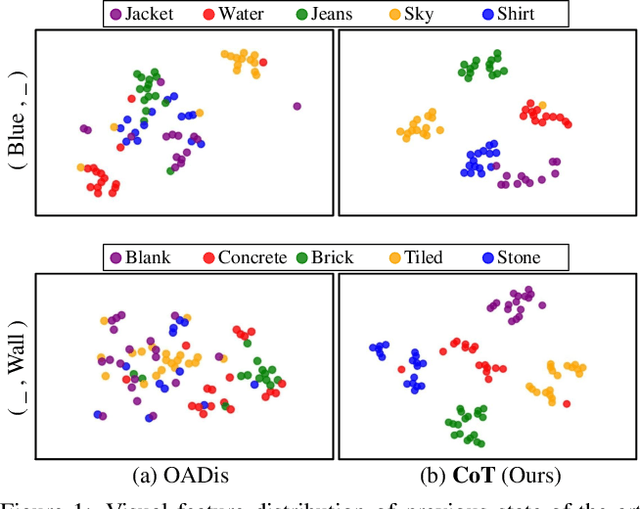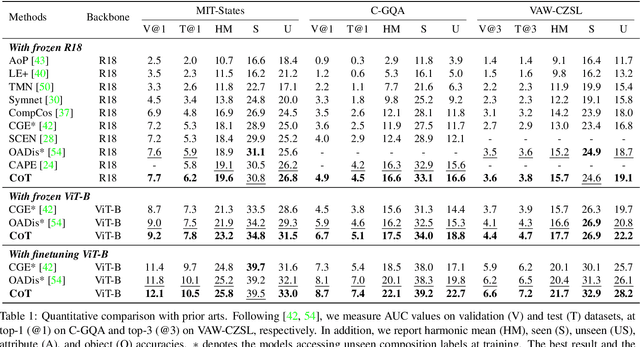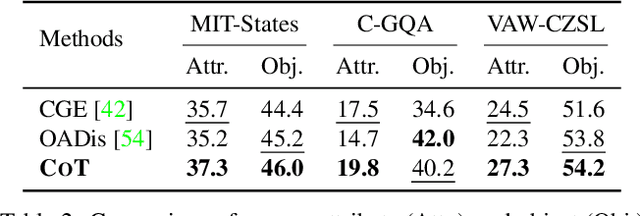Jiyoung Lee
Bootstrap Your Own Views: Masked Ego-Exo Modeling for Fine-grained View-invariant Video Representations
Mar 25, 2025Abstract:View-invariant representation learning from egocentric (first-person, ego) and exocentric (third-person, exo) videos is a promising approach toward generalizing video understanding systems across multiple viewpoints. However, this area has been underexplored due to the substantial differences in perspective, motion patterns, and context between ego and exo views. In this paper, we propose a novel masked ego-exo modeling that promotes both causal temporal dynamics and cross-view alignment, called Bootstrap Your Own Views (BYOV), for fine-grained view-invariant video representation learning from unpaired ego-exo videos. We highlight the importance of capturing the compositional nature of human actions as a basis for robust cross-view understanding. Specifically, self-view masking and cross-view masking predictions are designed to learn view-invariant and powerful representations concurrently. Experimental results demonstrate that our BYOV significantly surpasses existing approaches with notable gains across all metrics in four downstream ego-exo video tasks. The code is available at https://github.com/park-jungin/byov.
Single Ground Truth Is Not Enough: Add Linguistic Variability to Aspect-based Sentiment Analysis Evaluation
Oct 13, 2024



Abstract:Aspect-based sentiment analysis (ABSA) is the challenging task of extracting sentiment along with its corresponding aspects and opinions from human language. Due to the inherent variability of natural language, aspect and opinion terms can be expressed in various surface forms, making their accurate identification complex. Current evaluation methods for this task often restrict answers to a single ground truth, penalizing semantically equivalent predictions that differ in surface form. To address this limitation, we propose a novel, fully automated pipeline that augments existing test sets with alternative valid responses for aspect and opinion terms. This approach enables a fairer assessment of language models by accommodating linguistic diversity, resulting in higher human agreement than single-answer test sets (up to 10%p improvement in Kendall's Tau score). Our experimental results demonstrate that Large Language Models (LLMs) show substantial performance improvements over T5 models when evaluated using our augmented test set, suggesting that LLMs' capabilities in ABSA tasks may have been underestimated. This work contributes to a more comprehensive evaluation framework for ABSA, potentially leading to more accurate assessments of model performance in information extraction tasks, particularly those involving span extraction.
Read, Watch and Scream! Sound Generation from Text and Video
Jul 08, 2024



Abstract:Multimodal generative models have shown impressive advances with the help of powerful diffusion models. Despite the progress, generating sound solely from text poses challenges in ensuring comprehensive scene depiction and temporal alignment. Meanwhile, video-to-sound generation limits the flexibility to prioritize sound synthesis for specific objects within the scene. To tackle these challenges, we propose a novel video-and-text-to-sound generation method, called ReWaS, where video serves as a conditional control for a text-to-audio generation model. Our method estimates the structural information of audio (namely, energy) from the video while receiving key content cues from a user prompt. We employ a well-performing text-to-sound model to consolidate the video control, which is much more efficient for training multimodal diffusion models with massive triplet-paired (audio-video-text) data. In addition, by separating the generative components of audio, it becomes a more flexible system that allows users to freely adjust the energy, surrounding environment, and primary sound source according to their preferences. Experimental results demonstrate that our method shows superiority in terms of quality, controllability, and training efficiency. Our demo is available at https://naver-ai.github.io/rewas
Bridging Vision and Language Spaces with Assignment Prediction
Apr 15, 2024Abstract:This paper introduces VLAP, a novel approach that bridges pretrained vision models and large language models (LLMs) to make frozen LLMs understand the visual world. VLAP transforms the embedding space of pretrained vision models into the LLMs' word embedding space using a single linear layer for efficient and general-purpose visual and language understanding. Specifically, we harness well-established word embeddings to bridge two modality embedding spaces. The visual and text representations are simultaneously assigned to a set of word embeddings within pretrained LLMs by formulating the assigning procedure as an optimal transport problem. We predict the assignment of one modality from the representation of another modality data, enforcing consistent assignments for paired multimodal data. This allows vision and language representations to contain the same information, grounding the frozen LLMs' word embedding space in visual data. Moreover, a robust semantic taxonomy of LLMs can be preserved with visual data since the LLMs interpret and reason linguistic information from correlations between word embeddings. Experimental results show that VLAP achieves substantial improvements over the previous linear transformation-based approaches across a range of vision-language tasks, including image captioning, visual question answering, and cross-modal retrieval. We also demonstrate the learned visual representations hold a semantic taxonomy of LLMs, making visual semantic arithmetic possible.
KorNAT: LLM Alignment Benchmark for Korean Social Values and Common Knowledge
Feb 22, 2024Abstract:For Large Language Models (LLMs) to be effectively deployed in a specific country, they must possess an understanding of the nation's culture and basic knowledge. To this end, we introduce National Alignment, which measures an alignment between an LLM and a targeted country from two aspects: social value alignment and common knowledge alignment. Social value alignment evaluates how well the model understands nation-specific social values, while common knowledge alignment examines how well the model captures basic knowledge related to the nation. We constructed KorNAT, the first benchmark that measures national alignment with South Korea. For the social value dataset, we obtained ground truth labels from a large-scale survey involving 6,174 unique Korean participants. For the common knowledge dataset, we constructed samples based on Korean textbooks and GED reference materials. KorNAT contains 4K and 6K multiple-choice questions for social value and common knowledge, respectively. Our dataset creation process is meticulously designed and based on statistical sampling theory and was refined through multiple rounds of human review. The experiment results of seven LLMs reveal that only a few models met our reference score, indicating a potential for further enhancement. KorNAT has received government approval after passing an assessment conducted by a government-affiliated organization dedicated to evaluating dataset quality. Samples and detailed evaluation protocols of our dataset can be found in https://selectstar.ai/ko/papers-national-alignment
Dense Text-to-Image Generation with Attention Modulation
Aug 24, 2023Abstract:Existing text-to-image diffusion models struggle to synthesize realistic images given dense captions, where each text prompt provides a detailed description for a specific image region. To address this, we propose DenseDiffusion, a training-free method that adapts a pre-trained text-to-image model to handle such dense captions while offering control over the scene layout. We first analyze the relationship between generated images' layouts and the pre-trained model's intermediate attention maps. Next, we develop an attention modulation method that guides objects to appear in specific regions according to layout guidance. Without requiring additional fine-tuning or datasets, we improve image generation performance given dense captions regarding both automatic and human evaluation scores. In addition, we achieve similar-quality visual results with models specifically trained with layout conditions.
Hierarchical Visual Primitive Experts for Compositional Zero-Shot Learning
Aug 08, 2023



Abstract:Compositional zero-shot learning (CZSL) aims to recognize unseen compositions with prior knowledge of known primitives (attribute and object). Previous works for CZSL often suffer from grasping the contextuality between attribute and object, as well as the discriminability of visual features, and the long-tailed distribution of real-world compositional data. We propose a simple and scalable framework called Composition Transformer (CoT) to address these issues. CoT employs object and attribute experts in distinctive manners to generate representative embeddings, using the visual network hierarchically. The object expert extracts representative object embeddings from the final layer in a bottom-up manner, while the attribute expert makes attribute embeddings in a top-down manner with a proposed object-guided attention module that models contextuality explicitly. To remedy biased prediction caused by imbalanced data distribution, we develop a simple minority attribute augmentation (MAA) that synthesizes virtual samples by mixing two images and oversampling minority attribute classes. Our method achieves SoTA performance on several benchmarks, including MIT-States, C-GQA, and VAW-CZSL. We also demonstrate the effectiveness of CoT in improving visual discrimination and addressing the model bias from the imbalanced data distribution. The code is available at https://github.com/HanjaeKim98/CoT.
VisAlign: Dataset for Measuring the Degree of Alignment between AI and Humans in Visual Perception
Aug 03, 2023Abstract:AI alignment refers to models acting towards human-intended goals, preferences, or ethical principles. Given that most large-scale deep learning models act as black boxes and cannot be manually controlled, analyzing the similarity between models and humans can be a proxy measure for ensuring AI safety. In this paper, we focus on the models' visual perception alignment with humans, further referred to as AI-human visual alignment. Specifically, we propose a new dataset for measuring AI-human visual alignment in terms of image classification, a fundamental task in machine perception. In order to evaluate AI-human visual alignment, a dataset should encompass samples with various scenarios that may arise in the real world and have gold human perception labels. Our dataset consists of three groups of samples, namely Must-Act (i.e., Must-Classify), Must-Abstain, and Uncertain, based on the quantity and clarity of visual information in an image and further divided into eight categories. All samples have a gold human perception label; even Uncertain (severely blurry) sample labels were obtained via crowd-sourcing. The validity of our dataset is verified by sampling theory, statistical theories related to survey design, and experts in the related fields. Using our dataset, we analyze the visual alignment and reliability of five popular visual perception models and seven abstention methods. Our code and data is available at \url{https://github.com/jiyounglee-0523/VisAlign}.
Panoramic Image-to-Image Translation
Apr 11, 2023



Abstract:In this paper, we tackle the challenging task of Panoramic Image-to-Image translation (Pano-I2I) for the first time. This task is difficult due to the geometric distortion of panoramic images and the lack of a panoramic image dataset with diverse conditions, like weather or time. To address these challenges, we propose a panoramic distortion-aware I2I model that preserves the structure of the panoramic images while consistently translating their global style referenced from a pinhole image. To mitigate the distortion issue in naive 360 panorama translation, we adopt spherical positional embedding to our transformer encoders, introduce a distortion-free discriminator, and apply sphere-based rotation for augmentation and its ensemble. We also design a content encoder and a style encoder to be deformation-aware to deal with a large domain gap between panoramas and pinhole images, enabling us to work on diverse conditions of pinhole images. In addition, considering the large discrepancy between panoramas and pinhole images, our framework decouples the learning procedure of the panoramic reconstruction stage from the translation stage. We show distinct improvements over existing I2I models in translating the StreetLearn dataset in the daytime into diverse conditions. The code will be publicly available online for our community.
Three Recipes for Better 3D Pseudo-GTs of 3D Human Mesh Estimation in the Wild
Apr 10, 2023Abstract:Recovering 3D human mesh in the wild is greatly challenging as in-the-wild (ITW) datasets provide only 2D pose ground truths (GTs). Recently, 3D pseudo-GTs have been widely used to train 3D human mesh estimation networks as the 3D pseudo-GTs enable 3D mesh supervision when training the networks on ITW datasets. However, despite the great potential of the 3D pseudo-GTs, there has been no extensive analysis that investigates which factors are important to make more beneficial 3D pseudo-GTs. In this paper, we provide three recipes to obtain highly beneficial 3D pseudo-GTs of ITW datasets. The main challenge is that only 2D-based weak supervision is allowed when obtaining the 3D pseudo-GTs. Each of our three recipes addresses the challenge in each aspect: depth ambiguity, sub-optimality of weak supervision, and implausible articulation. Experimental results show that simply re-training state-of-the-art networks with our new 3D pseudo-GTs elevates their performance to the next level without bells and whistles. The 3D pseudo-GT is publicly available in https://github.com/mks0601/NeuralAnnot_RELEASE.
 Add to Chrome
Add to Chrome Add to Firefox
Add to Firefox Add to Edge
Add to Edge